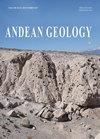受不同火山作用影响的两个三叠纪湖系棘尾虫的埋藏学分析
IF 0.9
4区 地球科学
Q1 Earth and Planetary Sciences
引用次数: 0
摘要
刺尾纲是淡水枝足类。淡水环境中刺毛虫种群的生长发育取决于各种物理、化学和生物因素。在湖相沉积的石化过程中,火山作用改变了湖泊学参数。本研究确定了阿根廷两个三叠纪湖系的棘足动物组合,并根据火山活动分析了壳的保存动力学。定义了两个埋藏等级,分为三个不同的第二埋藏等级。研究的重点是刺虫的丰度和丰富度随时间、不同古环境条件的变化,以及壳的保存和化学成分。讨论强调了熔岩流流入和火山灰落在不同湖泊系统中的重要性。我们强调对棘足类进行地学研究对于了解其在三叠纪湖泊系统中的本地种群和外来种群的重要性。因此,壳体的死后过程、在水-沉积物界面的暴露时间以及周围火山活动对进入古湖泊的水的化学变化可以解释这两个三叠纪湖泊体系中棘骨藻的发育和保存。本文章由计算机程序翻译,如有差异,请以英文原文为准。
Taphonomic analysis of Spinicaudata from two Triassic lacustrine systems affected by different volcanic processes
Spinicaudata are freshwater branchiopods. The growth and development of spinicaudata populations in freshwater environments depend on various physical, chemical, and biological factors. The action of volcanism modifies the limnological parameters in the process of fossilization of lacustrine deposits. This study identifies spinicaudatan assemblages in two Triassic lake systems in Argentina, and analyzes the dynamics of shell preservation according to the volcanic activity involved. Two taphonomic grades divided into three different second taphonomic grades were defined. The focus on taphonomic and chemistry studies addresses changes in spinicaudata abundance and richness through time, in different paleoenvironmental conditions, and shell preservation and chemical composition. The discussion highlights the importance of lava flow inflow and volcanic ash fall in the different lake systems. We emphasize the importance of taphonomic studies on the spinicaudata groups to understand their autochthonous and allochthonous populations in Triassic lake systems. In turn, we conclude that the post mortem processes experienced by the shells, the exposure time at the water-sediment interface, and the chemical alteration of the water into the paleolakes produced by the surrounding volcanic activity can explain the development and preservation of spinicaudata in these two Triassic lacustrine systems.
求助全文
通过发布文献求助,成功后即可免费获取论文全文。
去求助
来源期刊

Andean Geology
地学-地质学
CiteScore
2.60
自引率
0.00%
发文量
17
审稿时长
>12 weeks
期刊介绍:
This journal publishes original and review articles on geology and related sciences, in Spanish or English, in three issues a year (January, May and September). Articles or notes on major topics of broad interest in Earth Sciences dealing with the geology of South and Central America and Antarctica, and particularly of the Andes, are welcomed.
The journal is interested in publishing thematic sets of papers and accepts articles dealing with systematic Paleontology only if their main focus is the chronostratigraphical, paleoecological and/or paleogeographical importance of the taxa described therein.
 求助内容:
求助内容: 应助结果提醒方式:
应助结果提醒方式:


